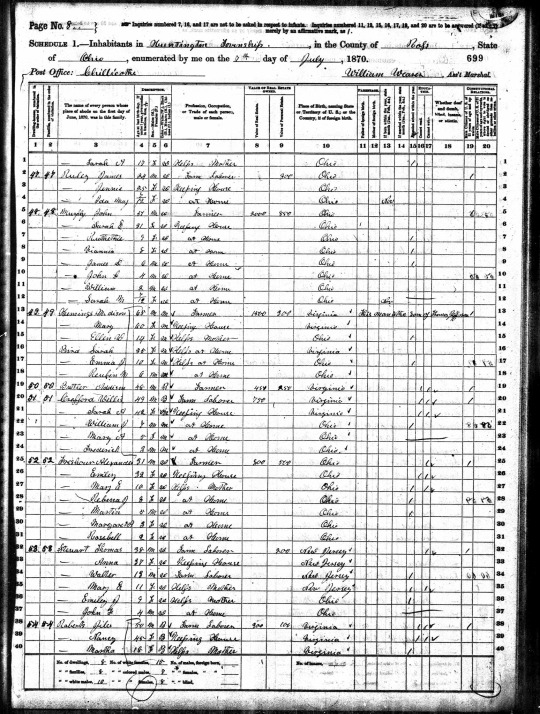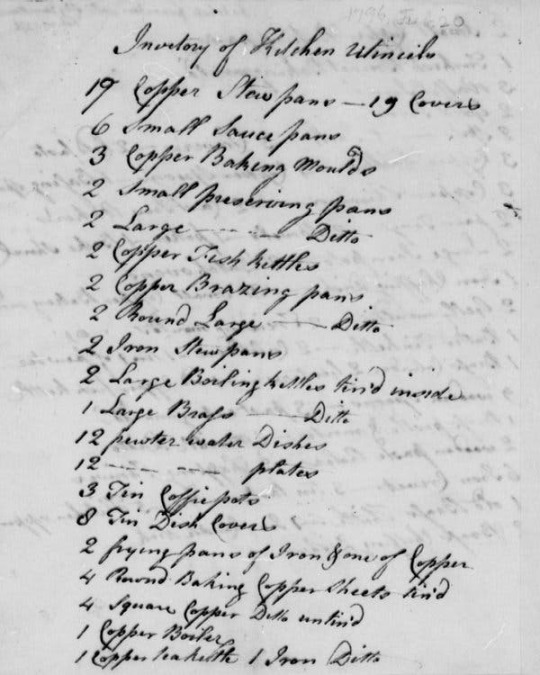#james hemings
Explore tagged Tumblr posts
Text
Interesting information about the dessert he made for the Dinner-Table Bargain.
#alexander hamilton#james hemings#james madison#thomas jefferson#dinner table bargain#the room where it happens#baked alaska#master chef
11 notes
·
View notes
Text
R.I.P. James Hemings you would've crushed this challenge (The show basically challenges American chefs to learn French baking).


Good for him being an amazing chef 💪💪💪
I want to learn more about him. I've learned about him mostly at Monticello and the occasional original recipe in historical restaurants! In short, James Hemings was enslaved by Thomas Jefferson and trained in French cuisine during Jefferson's time there. He eventually negotiated his freedom and he is a sibling of Sally Hemings.
Here is Monticello's webpage about him if you want to learn more.
2 notes
·
View notes
Text
#sally hemings#thomas jefferson#jefferson in paris edit#jefferson in paris#movie amv#movie edit#movie#movie film#film#historical fiction#edits#edit#patsy jefferson#martha jefferson#maria cosway#james hemings
16 notes
·
View notes
Text
James Hemings is the black slave who actually should be credited with mac and cheese. Jefferson ate it but Hemings (yes, related to Sally Hemings) did all the creative and physical labor.

324 notes
·
View notes
Text
To the mother fucker in the Hamilton fandom who wrote that kindergarten au fanfic of toddler Thomas Jefferson beating up a doll named after Sally Hemings and having James Madison cry about how he shouldn’t hit her and should take care of his toys and and Jefferson said “It’s just a doll”
I hope you have permanent nightmares
10 notes
·
View notes
Text



𝔐𝔢𝔱𝔞𝔩𝔩𝔦𝔠𝔞, 𝔟𝔞𝔠𝔨𝔰𝔱𝔞𝔤𝔢 𝔡𝔲𝔯𝔦𝔫𝔤 𝔐𝔬𝔫𝔰𝔱𝔢𝔯𝔰 𝔬𝔣 ℜ𝔬𝔠𝔨 յգՑԴ 𝔱𝔬𝔲𝔯
📷 ℜ𝔬𝔰𝔰 ℌ𝔞𝔩𝔣𝔦𝔫
#Metallica#Ross Halfin#backstage#Monsters of Rock#1987#tour#The $5.98 EP - Garage Days Re-Revisited#The $5.98 EP - Garage Days Re-Revisited era#kirk hammett#james hetfield#lars ulrich#jason newsted#Genre:#Thrash Metal#hemes:#Introspection#Anger#Corruption#Deceit#Death#Life#Metal#USA
56 notes
·
View notes
Text
Here's a fun little thing i found: Federal census of the year 1870 of Ross County, Ohio. Enumerator broke protocol to note of James Madison Hemings (mixed race son of Thomas Jefferson and Sally Hemings), the quoted note reads: "This man is the son of Thomas Jefferson!" I adore little pieces of history like this. Like, this isn't even necessary to put down in a census. Why is this in a census? Other than that, this was a pretty cool find.


7 notes
·
View notes
Text
Happy Black History Month

This is James Hemings
The brother of Sally Hemings
He, along with his sister Sally, were slaves of Thomas Jefferson
He created what we Today call Macaroni n Cheese 🧀 that we all love
#james hemings#sally hemings#thomas jefferson#foundational black american#fba history#foundational black american history#mac n cheese#88#United States#America#black excellence#black history
425 notes
·
View notes
Text
The USA Has the Separation of Church and State ~ Let Us Not Revert to Male Chauvinism ~ Nor One Brand of Religious Belief Over Another in the Halls of USA Government
Combining Church and State in state and federal regulations and as the Speaker of the House of Representatives is not what our Forefathers set up for the United States of America. Freedom is freedom, not censorship, nor male domination. It is time to pull off the systemic racism bandage covering the infected national wound masking as a difference of opinion. Blaming religion and religion’s…

View On WordPress
#Annette Gordon-Reed#book banning#censorship#church and state#freedom#Harvard University#James Madison#John Adams#June 19#Juneteenth#Juonson#male chuvinism#racism#Republicans#slavery#Speaker of the House#Speaker of the House of Representatives#The Hemings of Monticello#Thomas Jefferson#Thomas Paine#US#USA#white
0 notes
Text
Americans [...] would sip the rich cocoa as a hot drink. Cocoa made its way to North America on the same ships that transported rum and sugar from the Caribbean and South America [...] and was heavily reliant on the labor of enslaved Africans throughout the diaspora. [...] [B]y the early 1700s, Boston, Newport, New York and Philadelphia were processing cocoa into chocolate to export and to sell domestically. Chocolate was popular in the coffeehouse culture and was processed for sale and consumption by enslaved laborers in the North. Farther south, in Virginia, cocoa was becoming [...] so popular that it is estimated that approximately one-third of Virginia’s elite was consuming cocoa in some form or another. For the wealthy, this treat was sipped multiple times a week; for others it was out of reach. [...]
The art of chocolate-making – roasting beans, grinding pods onto a stone over a small flame – was a labor-intensive task. An enslaved cook would have had to roast the cocoa beans on the open hearth, shell them by hand, grind the nibs on a heated chocolate stone, and then scrape the raw cocoa, add milk or water, cinnamon, nutmeg or vanilla, and serve it piping hot.
---
One of the first chocolatiers in the Colonies was an enslaved cook named Caesar.
Born in 1732, Caesar was the chef at Stratford Hall, the home of the Lees of Virginia, and in his kitchen sat one of only three chocolate stones in the Colony. The other two were located at the governor’s palace and at the Carter family estate, belonging to one of the wealthiest families in Virginia. Caesar was responsible for cooking multiple meals a day for the Lees and any free person who came to visit. [...]
---
The work was oppressive in the plantation kitchens at Christmas time. [...]
[T]hose working in the big house kitchen and as domestic laborers were expected to work around the clock to ensure a perfect holiday for the white family. The biggest task at hand was to cook and serve Christmas dinner, and chocolate was a favorite addition to the three-course formal dinner. [...] Oyster stew, meat pies, roasted pheasant, puddings, roasted suckling pig and Virginia ham are some of the many dishes that would be served in just one course. The night would finish with the sipping of chocolate: toasted, ground and spiced [...] and served in sipping-cups made specifically for drinking chocolate. [...]
---
Decades before the two well-known enslaved chefs, Monticello’s James Hemings and George Washington’s Chef Hercules, [...] Caesar was running one of the Colonies’ most prestigious kitchens inside of Stratford Hall, and making chocolate for the Lees and their guests. [...] [H]is son, Caesar Jr., lived nearby and was the postillion [...].
The stress of cooking the most important dinner of the year was combined with the fear of what was to come on Jan. 1. New Year’s Day was commonly known as heartbreak day, when enslaved folks would be sold to pay off debts or rented out to a different plantation. Jan. 1 represented an impending doom, and the separation of families and loved ones. [...] Caesar disappeared from the records by the end of the 18th century. By 1800, his son Caesar Jr. was still owned by the Lees, but as that year ended, Christmas came and went, and Caesar Jr. was put up for collateral by Henry Lee for payment of his debts.
---
The world Caesar lived in was one fueled by the Columbian Exchange, which was built from enslaved labor [...]: pineapples, Madeira wine, port, champagne, coffee, sugar and cocoa beans. These items traveled from plantation to dining room via the Atlantic trade, and were central to securing the reputation of Virginia’s plantation elite. The more exotic and delicious the food, the more domestic fame one would reap. Having cocoa delivered directly to your home, and having a chocolatier in the kitchen, were exceptional. It was through Caesar’s culinary arts that Stratford Hall became well-known throughout Colonial Virginia as a culinary destination.
---
All text above by: Kelley Fanto Deetz. “Oppression in the kitchen, delight in the dining room: The story of Caesar, an enslaved chef and chocolatier in Colonial Virginia.” The Conversation. 21 December 2020. [Bold emphasis and some paragraph breaks/contractions added by me.]
347 notes
·
View notes
Text
wip list for the New York Times books of the century (going for favorites + influence rather than just influence)
Milkman by Anna burns (changed and reaffirmed my personal sense of the novel)
jesus and John Wayne by Kristin kobes du mez (essential to modern America. Essential)
l’amica geniale by Elena ferrante (famous and influential!)
A brief history of seven killings - marlon James
to the end of the land - David grossman
Gilead - Marilynne Robinson (famous + influential)
everything is illuminated - Jonathan safran foer
La temporada de huricanes/hurricane season -Fernanda Melchior
In the country - Mia alvar
the descendants - kaui hart Hemings
22 notes
·
View notes
Text
About Reu
"So then,"

⋆✴︎˚。⋆
Name: Reuben (or Reu)
Pronouns: He/They
Age: 19
Timezone: EST (UTC-05:00)
Welcome to my blog! I mostly post art and my history shenanigans on here, but I hope to start posting historical research, rants, and whatnot. I mostly draw amrev stuff but you'll see my other interests sprinkled around here and there as well.
Most common tags: #reu's art (my art), #amrev (my main interest), #Aaron Burr
A little bit about me...
I am a full time undergraduate majoring history, and double minoring studio art + historic preservation. I'm also a university guide and love rambling about our university's past – I focus on our 19th century history.
I've researched the founding era of the US for almost 6 years now, and I've extensively researched Aaron Burr and Thomas Jefferson (note, I hate Thomas Jefferson. I hate him because of my extensive knowledge on him, not in spite of it).
I also focus my research on:
John Marshall
James Madison
Luther Martin
Richard Montgomery
Thomas Paine
Marquis de Lafayette
The Hemings and others enslaved at Monticello and UVA
Virginia regional history
History of enslaved people
And goodness, so, so much more. You'll notice that I draw Burr the most though. He's my go-to person to draw. Many say that I am quite normal about Burr (I am not).
Academic interests: 1770's-1810's U.S history (special interest), astronomy, abnormal psychology, developmental psychology, theoretical physics, biology, religious philosophy, and more 📖
My favorite amrev media: 1776 The Musical, HBO: John Adams, TURN: Washington's Spies, I Made America (Does anyone know what IMA is... Anyone..please..), and more
Other interests: Witchcraft/paganism (I am pagan), ttrpgs, Project Sekai, Vocaloid (Kikuo, Iyowa, Maretu, etc), Arcane, Spiderverse, Bojack Horseman, J-Pop (Ado, Tatsuya Kitani, etc), BBC Ghosts, Will Wood, Mitski, MLP, Steven Universe, Good Omens, The Owl House, animation, Hadestown, Falsettos, singing, and more
My user is reueslee pretty much everywhere, if you'd like to find me elsewhere. I'm most active on here and Instagram.
Heigh-Ho! 💁🏽
. ݁₊⊹. ݁˖ .

"we'll be okay."
5 notes
·
View notes
Text

You’re Loud and wrong

Love Mac and Cheese? You Can Thank the Slave of a Founding Father for It
Claire Barrett11/1/2022

You can thank Thomas Hemings, once enslaved to Thomas Jefferson, for bringing the dish to America.
If you’re an American who has ever indulged in a hot, delectable, creamy, comforting side of macaroni and cheese, you can thank the slave of a Founding Father for bringing the dish to America.
While historians cite the 13th century Italian cookbook “Liber de Coquina” as the first written and recognized macaroni and cheese recipe — a dish called de lasanis — the classic American side item arrived by way of France — courtesy of James Hemings.
Born in 1765, Hemings was the sixth child born to Elizabeth Hemings, an enslaved woman, and owner John Wayles. Wayles, the father-in-law of Thomas Jefferson, fathered six of Hemings’ children — making them half brothers and sisters of Jefferson’s wife, Martha, according toMonticello Magazine.
Upon Jefferson’s marriage to Martha, Hemings and his siblings —including Sally Hemings — became property of the Founding Father to be.
Not only could Hemings read and write — a rarity for the times — he was also an accomplished chef.
GET HISTORY’S GREATEST TALES—RIGHT IN YOUR INBOX
Subscribe to our HistoryNet Now! newsletter for the best of the past, delivered every Wednesday.
So, when Jefferson was appointed Minister to France from 1784 to 1789, the notorious Francophile and “foodie” brought along the 19-year-old Hemings with the intention of having him train among the Parisian elite.
According to the White House Historical Association, “French chefs were very expensive to employ, and Jefferson’s costs regularly outpaced his income. While Jefferson may have been short on cash, he did have an abundant supply of readily available enslaved labor, bound to serve him for life. To save money, Jefferson employed French chefs to train several enslaved members of the Monticello community in the delicate art of French cookery.”
This included, of course, what we now consider mac and cheese.
From Italy to the rest of Western Europe, the widespread culinary exchange happening in courts throughout Europe at the time morphed the Italian dish into an altered version that made its way to England, called macrows, and France. It’s disputed whether Jefferson first discovered the creamy pasta dish in Italy or France, but what isn’t under dispute is his love for it.
In 1807, Jefferson purchased 80 pounds of parmesan cheese and 60 pounds of Naples-based macaroni. His last grocery order, placed five months before his death in 1826, included “Maccaroni 112 ¾ lb,” according to EatingWell. (Despite such large quantities of simple carbohydrates and dairy, Jefferson did not, in fact, die of a heart attack. He did, however, contract a nasty infection on his buttocks which most likely developed into septicemia, causing his death.)
As Jefferson’s primary chef, Hemings is certain to have mastered the perfect balance of butter, cheese and macaroni.
youtube
During his time in France, Hemings apprenticed with a caterer, a pastry chef and even as a chef for the prince de Conde.
“For an American to go and learn that … was pretty incredible,” food historian Paula Marcoux — who has recreated classic French dishes of the era at Monticello, using the same types of cooking tools Hemings would have used — told NPR.
In 1787, Hemings was appointed chef de cuisine at Jefferson’s home in Paris, supervising white servants in the kitchen among other duties. And, in 1789, despite finding out that under French law, he was a free man, Hemings elected to return to Virginia with Jefferson, enslaved.
“Family,” historian Annette Gordon-Reed told NPR. “There was a real dilemma for many enslaved people: Do you take your freedom and separate yourself from your family?”
Hemings continued in his position as an enslaved chef under Jefferson, moving to New York and Philadelphia with the latter as he served as the secretary of state under President George Washington.
In 1793, however, Hemings successfully bargained for his freedom — with a caveat.
“Hemings would return to Monticello to train another enslaved person in French cooking to serve as a replacement chef. Once the replacement chef was properly trained, Jefferson agreed that Hemings ‘shall be thereupon made free, and I will thereupon execute all proper instruments to make him free,’” according to the White House Historical Association.
Hemings began training his brother, Peter Hemings, but it would be three long years until Jefferson assented to James’ freedom.
In the 1796 deed of manumission, Jefferson wrote, “I Thomas Jefferson of Monticello aforesaid do emancipate, manumit and make free James Hemings, son of Betty Hemings, which said James is now of the age of thirty years so that in the future he shall be free and of free condition, and discharged of all duties and claims of servitude whatsoever, and shall have all the rights and privileges of a freedman.”
Of the 607 men and women Jefferson owned during his lifetime, according to Susan Stein, senior curator at Monticello, only two had ever negotiated for their freedom. James Hemings was one of them.
Only several years after finding his freedom, Hemings tragically died by suicide in 1801.
While he left no memoirs, he did leave his recipes. And America — although not our cholesterol levels — is better for them.
historynet magazines
Our 9 best-selling history titles feature in-depth storytelling and iconic imagery to engage and inform on the people, the wars, and the events that shaped America and the world.
#Google is the most free app on the market bitch#Youtube#Touch grass#I heard that you were getting massacred#in your comments section.#Saved you a google search#do better instead of rage baiting#Yes Kraft Mac and cheese is not.#BAKED Mac and cheese is credited to an enslaved man#Black history#black liberation#black community#black power#black people#black culture#black history 365#black history is world history#black history month#black history matters#black history is american history
5 notes
·
View notes
Text
Today is Thomas Jefferson's birthday
But I hate Thomas Jefferson a lot. We don't actually know Sally Heming's birthday although we know the year was around 1773, so I'm just going to take today to honor her. Imagine, just for a second, if she lived in the modern age. She could've had a good life. She could've had a childhood without rape and pedophiles and endless work. She could've had a family, a real good one. Instead, she was born into slavery and had a horrible life. She was only a quarter black. She had relatively straight black hair. Looks like she might've had brown eyes. Take a moment to honor her. Her brother, James, too. He was an amazing chef who actually invented macaroni and cheese. Just take a moment, to honor every slave who never got a good life because of their SKIN.

14 notes
·
View notes
Photo

CANCER on stage in Germany during their "Death Shall Rise" European Tour back in October 1991... from L to R: James Murphy, John Walker & Ian Buchanan.
(scan from Thrash 'n Burn Magazine #5)
#CANCER#Death Shall Rise#Germany#European Tour#Tour#stage#1991#90s#90's#James Murphy#John Walker#Ian Buchanan#metal#Genre: Death/Thrash Metal#Thrash 'n Burn Magazine#hemes: Gore Horror Death Society#UK
54 notes
·
View notes
Text
6 Black Chefs (and 1 Inventor) Who Changed the History of Food - The New York Times
James Hemings
First American to train as a chef in France
Cooked the historic meal between Alexander Hamilton and Thomas Jefferson (immortalized in the musical “Hamilton” in the song “The Room Where It Happens”)
Introduced European-style macaroni and cheese, French fries, crème brûlée and ice cream to America
James Hemings was born in Virginia in 1765; at 8 years old, he became Thomas Jefferson’s slave through an inheritance. (His younger sister Sally was also enslaved by Jefferson and later bore several of Jefferson’s children.)
After Jefferson was appointed commerce minister to France in 1784, he and Hemings, then 19 years old, set sail for Paris, which is where Hemings began his cooking career, becoming the first American trained as a French chef. He studied in prestigious French kitchens and trained with a master pastry chef; his most important experience, however, came from the chef at the Château de Chantilly, which at the time was considered to have better food than Versailles.
Image

In 1787, Hemings became the chef de cuisine at Hôtel de Langeac, Jefferson’s personal residence, where he cooked for politicians and celebrities. He later would make the dinner for the historic meeting between Jefferson and Alexander Hamilton in Virginia, where the two men engaged in political negotiations despite their longstanding feud.
#James Hemmings#Black Culinary History#Macaroni and Cheese#andrew jefferson#enslaved Black Culinarian#Black Food#Black Foodies#soul food#Sally Hemmings#Black History Matters
7 notes
·
View notes